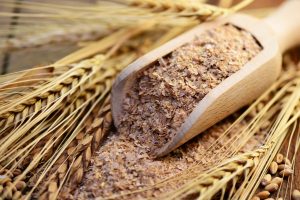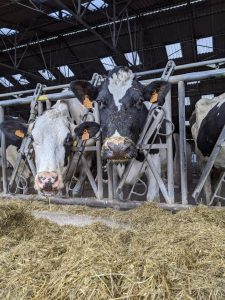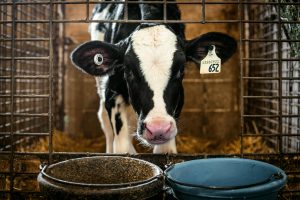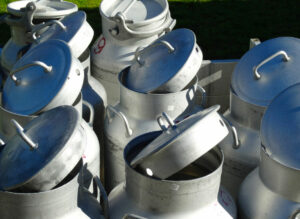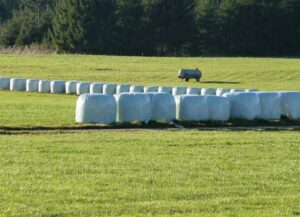Álvaro García
Lameness in dairy cows arises from diverse factors undermining hoof health and overall well-being, such as digital dermatitis, sole ulcers, and white line disease, often exacerbated by suboptimal living conditions and improper hoof care. Digital dermatitis, a bacterial infection between hoof claws, causes painful lesions that escalate without swift treatment. Sole ulcers result from pressure on the hoof, leading to tissue damage, while weakened hoof wall connections in white line disease facilitate bacterial invasion.
Beyond physical discomfort, lameness alters dairy cow behavior and physiology. Affected cows exhibit reduced mobility, favoring healthy limbs and disrupting feeding and social interactions within the herd. Increased lying down to alleviate pain can reduce feed intake and nutrition. Lameness induces stress responses, elevating cortisol levels and impairing reproductive health, linked to reduced fertility and disrupted estrus cycles. Behavioral changes like reduced mounting and estrus detection responsiveness further hinder breeding success.
Managing lameness necessitates a holistic approach integrating preventive measures, early detection, and effective treatment. Strategies include regular hoof trimming, comfortable resting surfaces, clean environments, and vaccination against hoof diseases. Prompt identification and treatment using hoof blocks, topical treatments, and veterinary care are critical to minimize health and reproductive impacts. Proactive hoof health management enhances cattle welfare and operational productivity in dairy farming.
Economic Implications
Recurrent lameness significantly impacts the economic viability of dairy operations. Treatment expenses, reduced milk yield, and losses due to delayed reproduction all contribute to substantial financial burdens. On average, treatment costs for lameness can range from $100 to $300 per cow annually, depending on the severity and frequency of treatments required. Research reports claim lameness typically results in an average reduction of 85 pounds of milk per affected cow annually. With an average milk price of $20 per hundredweight (cwt), this equates to a loss of $17 per cow per year in milk revenue alone.
In addition, cows with recurrent lameness experience longer calving intervals and reduced conception rates. This leads to fewer calves being born per year, directly affecting herd productivity and profitability. The economic impact of delayed reproduction and increased culling rates due to lameness can result in additional costs of up to $200 per cow annually, factoring in the need to purchase or breed replacement heifers. Furthermore treatment costs need to be considered as well. In total, and when considering treatment costs, milk production losses, and reproductive losses, the total economic impact of lameness can range from $300 to $500 per cow annually in additional expenses and lost revenue.
Management Strategies
To mitigate the detrimental effects of recurrent lameness on breeding outcomes in dairy cows, effective management strategies are essential. Implementing a rigorous regimen of hoof care is paramount. Dairy farmers should adhere to consistent schedules for hoof trimming and utilize footbaths to prevent and manage common hoof disorders, thereby minimizing the incidence of lameness. Regular inspections to identify and promptly treat hoof lesions are crucial, preventing minor issues from escalating into chronic problems that could compromise cow health and productivity.
Nutrition management plays a pivotal role in supporting overall health and reducing the risk of lameness. Ensuring a balanced diet with adequate nutrients not only promotes general well-being but also contributes to maintaining optimal body condition scores critical for reproductive performance. Supplementation with nutrients such as biotin and zinc further enhance hoof strength and integrity, enhancing the cow’s resilience against lameness-inducing conditions.
Environmental improvements within dairy housing facilities are equally essential. Providing comfortable housing equipped with ample bedding, proper ventilation, and non-slip flooring significantly reduces the occurrence of injuries that can lead to lameness. Ensuring cows have sufficient space to move and rest comfortably not only alleviates stress but also prevents complications associated with lameness, thereby maintaining herd health and productivity.
Monitoring and record-keeping are indispensable components of effective lameness management. Keeping detailed records of lameness incidents and treatment outcomes allows dairy farmers to identify trends and risk factors, facilitating targeted interventions to mitigate future occurrences. Regular monitoring of locomotion scores enables early detection of lameness signs, enabling prompt veterinary intervention and treatment, which is crucial for minimizing the impact on cow welfare and productivity.
In terms of breeding management, adopting advanced technologies such as activity monitors proves invaluable. These tools aid in estrus detection, even among cows exhibiting reduced estrus expression due to lameness-induced discomfort. Implementing strategic breeding programs that emphasize selecting for traits associated with optimal hoof health over successive generations can gradually reduce the prevalence of lameness within the herd. By integrating these comprehensive management strategies, dairy farmers can effectively safeguard their herd’s reproductive efficiency and overall profitability while ensuring the welfare and longevity of their cows.
A difficult to settle cow
Cow 913, a first lactation animal, is currently 414 days into her milking period. Recently diagnosed as pregnant 20 days ago, she maintains a body condition score (BCS) of 3.7, which is considered almost ideal for this stage of lactation. Notably, from around 250 days into her lactation, she has shown a trend of consistent condition gain, albeit with some variability but still falling within the expected range of values as reported by a modern 3D camera. She is currently producing nearly 58 pounds of milk, which exceeds expectations for this stage of her lactation.
Despite being in good condition and maintaining decent milk production, cow 913 faced significant challenges in becoming pregnant. Throughout her lactation, she maintained an adequate BCS. Her milk production, averaging almost 58 pounds per day at the present time, always exceeded typical expectations for each lactation stage. However, despite these favorable conditions, the data shows she required nine inseminations before being diagnosed pregnant. This prolonged reproductive challenge may stem from several factors. While high milk production levels can sometimes lead to metabolic demands that affect reproductive hormones, potentially delaying or disrupting estrus cycles it doesn’t seem the case here.
Her locomotion scores indicate fluctuations in mobility, always falling below ideal and reaching a drop in score of 1.3 in the 1-5 scale. There were recoveries followed by relapses which could influence her ability to exhibit estrus behaviors effectively. Changes in locomotion due to lameness or discomfort can impact estrus expression and hinder successful mating. These factors underscore the complexities involved in reproductive management, where balancing milk production, body condition, and estrus detection becomes crucial for achieving timely pregnancies.
Research has demonstrated significant associations between lameness and reproductive challenges in dairy cows, including increased breeding attempts. Lame cows tend to have lower conception rates, longer intervals between calvings, and require more insemination attempts compared to healthy cows. This is partly because lameness causes stress and pain, which can interfere with normal estrus cycles and reduce the likelihood of successful insemination.
To mitigate these issues, it is crucial to implement comprehensive lameness management strategies. This includes regular hoof trimming, providing comfortable resting surfaces, maintaining clean and dry environments, and ensuring balanced nutrition. These preventive measures, combined with prompt treatment of any hoof disorders, can significantly improve the overall health and reproductive performance of dairy cows, reducing the economic burden associated with multiple breeding attempts and prolonged calving intervals. Recurrent lameness poses a significant challenge to breeding efficiency in dairy cows, affecting hormonal balance, behavior, and physical capabilities. By adopting comprehensive strategies encompassing regular hoof care, balanced nutrition, improved housing, and advanced monitoring techniques, dairy farmers can mitigate lameness’s negative effects on breeding.
© 2025 Dellait Knowledge Center. All Rights Reserved.



